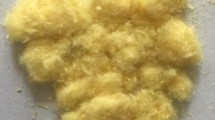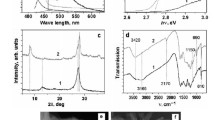Abstract
The graphitic carbon nitride (g-C3N4) is found to be an efficient photocatalyst for the reductive degradation of decabromodiphenyl ether (BDE209) under UV irradiation (>360 nm). g-C3N4 was prepared by heating dicyandiamide. X-ray diffraction, X-ray photoelectron spectroscopy, and UV-vis spectra were used to characterize the properties of as-prepared catalysts. The photoreductive degradation kinetics of BDE209 was further investigated under different reaction conditions. The degradation of BDE209 is a stepwise process, and the bromines at meta positions are much more susceptible to remove than those at the ortho and para positions. A possible photoreductive mechanism was also proposed.
Similar content being viewed by others
References
Alaee M, Arias P, Sjodin A, Bergman A. An overview of commercially used brominated flame retardants, their applications, their use patterns in different countries/regions and possible modes of release. Environ Int, 2003, 29: 683–689
Mai B, Chen S, Luo X, Chen L, Yang Q, Sheng G, Peng P, Fu J, Zeng E. Distribution of polybrominated diphenyl ethers in sediments of the Pearl River Delta and adjacent South China Sea. Environ Sci Technol, 2005, 39: 3521–3527
de Wit CA. An overview of brominated flame retardants in the environment. Chemosphere, 2002, 46: 583–624
Ikonomou MG, Rayne S, Addison RF. Exponential increases of the brominated flame retardants, polybrominated diphenyl ethers, in the Canadian Arctic from 1981 to 2000. Environ Sci Technol, 2002, 36: 1886–1892
Kierkegaard A, Balk L, Tjarnlund U, de Wit CA, Jansson B. Dietary uptake and biological effects of decabromodiphenyl ether in rainbow trout (Oncorhynchus mykiss). Environ Sci Technol, 1999, 33: 1612–1617
Meerts IATM, Letcher RJ, Hoving S, Marsh G, Bergman A, Lemman JG, van der Burg B, Brouwer A. In vitro estrogenicity of polybrominated diphenyl ethers, hydroxylated PBDEs, and polybrominated bisphenol A compounds. Environ Health Perspect, 2001, 109: 399–407
Norris JM, Ehrmantraut JW, Gibbons CL, Kociba RJ, Schwetz BA, Rose JQ, Humiston CG, Jewett GL, Crummett WB, Gehring PJ, Tirsell JB, Brosier JS. Toxicology and environmental factors involved in the selection of decabromodiphenyl oxide as a fire retardant chemical. Appl Polym Symp, 1973, 22: 195–219
Watanabe I, Tatsukawa R. Formation of brominated dibe-zofurans from the photolysis of flame retardant decabromo-biphenyl ether in hexane solution by UV and sunlight. Environ Contam Toxicol, 1987, 39: 953–959
Bezares-ruz J, Jafvert CT, Hua I. Solar photodecomposition of decabromodiphenyl ether: products and quantum yield. Environ Sci Technol, 2004, 38: 4149–4156
Gerecke AC, Hartmann PC, Heeb NV, Kohler HE, Giger W, Schmid P, Zennegg, M, Kohler M. Anaerobic degradation of decabromodiphenyl ether. Environ Sci Technol, 2005, 39: 1078–1083
Hua I, Kang N, Chad TJ, Fa’brega-Duque J. Heterogeneous photochemical reactions of decabromodiphenyl ether. Environ Toxicol Chem, 2003, 22, 798-804
Keum YS, Li QX. Reductive debromination of polybrominated diphenyl ethers by zerovalent iron. Environ Sci Technol, 2005, 39: 2280–2286
Sun CY, Zhao D, Chen CC, Ma WH, Zhao JC. TiO2-mediated photocatalytic debromination of decabromodiphenyl ether: Kinetics and intermediates. Environ Sci Technol, 2009, 43: 157–162
Nose KS, Hashimoto SJ, Takahashi S, Noma YK, Sakai SI. Degradation pathways of decabromodiphenyl ether during hydrothermal treatment. Chemosphere, 2007, 68:120–125
Wang XC, Chen XF, Thomas A, Fu XZ, Antonietti M. Metal-containing carbon nitride compounds: A new functional organicmetal hybrid material. Adv Mater, 2009, 21: 1609–1612
Wang Y, Wang XC, Antonietti M. Polymeric graphitic carbon nitride as a heterogenous organocatalyst: From photochemistry to multipurpose catalysis to sustainable chemistry. Angew Chem Int Ed, 2011, 50: 2–24
Liu G, Niu P, Sun CH, Smith SC, Chen ZG, Lu GQ, Cheng HM. Unique electronic structure induced high photoreactivity of sulfur-doped graphitic C3N4. J Am Chem Soc, 2010, 132: 11642–11648
Yue B Li Q, Iwai H, Kako T, Ye J. Hydrogen production using zinc-doped carbon nitride catalyst irradiated with visible light. Sci Technol Adv Mater, 2011, 12: 7
Cui YJ, Ding ZG, Liu P, Antonietti M, Fu XZ, Wang XC. Metal-free activation of H2O2 by g-C3N4 under visible light irradiation for the degradation of organic pollutants. Phys Chem Chem Phys, 2012, 14: 1455–1462
Yan SC, Li ZS, Zou ZG. Photodegradation of rhodamine B and methyl orange over boron-doped g-C3N4 under visible light irradiation. Langmuir, 2010, 26: 3894–3901
Goettmann F, Fischer A, Antonietti M, Thomas A. Chemical synthesis of mesoporous carbon nitrides using hard templates and their use as a metal-free catalyst for friedel-crafts reaction of benzene. Angew Chem Int Ed, 2006, 45: 4467
Korytár P, Covaci A, Boer J, Gelbin A, Brinkman UAT. Retention-time database of 126 polybrominated diphenyl ether congeners and two bromkal technical mixtures on seven capillary gas chromatographic columns. J Chromatogr A, 2005, 1065: 239–249
Wang YW, Li A, Liu HX, Zhang QH, Ma W, Song WL, Jiang GB. Development of quantitative structure gas chromatographic relative retention time models on seven stationary phases for 209 polybrominated diphenyl ether congeners. J Chromatogr A, 2006, 1103: 314–328
Zhao JC, Wu TX, Wu KQ, Oikawa KK, Hidaka H, Serpone N. Photoassisted degradation of dye pollutants: Evidence for the need for substrate adsorption on TiO2 particles. Environ Sci Technol, 1998, 32: 2394–2400
Author information
Authors and Affiliations
Corresponding author
Electronic supplementary material
Rights and permissions
About this article
Cite this article
Sun, C., Chen, C., Ma, W. et al. Photocatalytic debromination of decabromodiphenyl ether by graphitic carbon nitride. Sci. China Chem. 55, 2532–2536 (2012). https://doi.org/10.1007/s11426-012-4644-4
Received:
Accepted:
Published:
Issue Date:
DOI: https://doi.org/10.1007/s11426-012-4644-4




